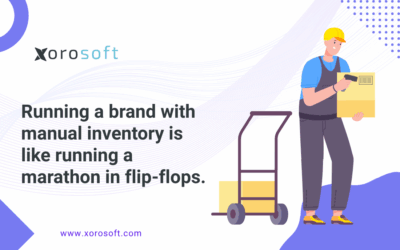
Why Inventory Workflow Automation Determines Whether Brands Plateau or Scale
Most ecommerce brands don’t fall behind because of their product or marketing. Instead, they stall because their inventory workflow automation is missing, incomplete, or fragmented. Since disconnected systems create delays, your team ends up fixing preventable inventory mistakes rather than driving growth.
Because of these gaps, operational friction expands far faster than revenue. Data becomes inconsistent, warehouse tasks become unpredictable, and purchasing becomes reactive. As a result, brands that should be scaling smoothly instead struggle with recurring inventory problems that drain time, margin, and morale.
What leaders really want is simple:
To spend their time scaling the brand—not working around broken processes.
This is why automated inventory workflows matter. When operational steps sync in real time, you remove the drag that slows down teams and erodes margins.
Common Inventory Workflow Frictions That Drain Operational Performance
Even when teams work hard, hidden frictions accumulate inside everyday workflows. Consequently, brands feel the impact long before they understand the cause.
Disconnected Systems That Create Bottlenecks
Inventory often lives across spreadsheets, shipping apps, marketplace tools, accounting systems, and standalone WMS platforms. Because these tools don’t naturally talk to each other, your team manually reconciles data. As a result, decisions become slow and error-prone.
Warehouse Processes Based on Tribal Knowledge
Many warehouses rely on unwritten rules and personal workarounds instead of structured workflows. Consequently, new hires struggle, accuracy varies, and mistakes repeat. Since peak seasons increase pressure, these weak points become painfully visible when volume spikes.
Purchasing Decisions Driven by Outdated Information
When purchasing relies on static spreadsheets or instinct, stockouts and overstocks happen frequently. Because data is outdated the moment it’s exported, teams react to problems instead of preventing them.
Accounting Delays That Obscure Financial Reality
Disconnected accounting systems struggle to reflect real-time inventory changes. As a result, financial visibility becomes cloudy, and leadership decisions rely on lagging or incomplete information.
Customer Experience Impacted by Back-End Issues
Overselling, backorders, and inaccurate stock levels create customer frustration. Although these problems appear at the customer layer, they originate in deeply manual operational processes.
Because of these combined frictions, many brands unintentionally cap their growth long before the market does.
How Automated Inventory Operations Unlock Real Growth
Transitioning to inventory workflow automation reshapes how teams operate, collaborate, and plan. Since automation replaces manual effort, every department gains visibility and consistency.
Inventory Accuracy That Stays Consistent Across Channels
When receiving, putaway, picking, transfers, and cycle counts sync automatically, the entire organization works from a unified truth. As a result, warehouse teams reduce mistakes, purchasing becomes smarter, and customer-facing teams provide accurate information.
Faster, More Accurate Fulfillment
Automated pick paths, mobile scanning, barcode workflows, and structured task assignments accelerate fulfillment. Because workflows become consistent, accuracy improves even as demand increases.
Predictive Purchasing That Reduces Stockouts
When forecasting blends sales velocity, seasonality, vendor lead times, and real-time demand, purchasing becomes proactive. Consequently, brands buy smarter, reduce stockouts, and avoid tying up excess capital.
Financial Clarity Powered by Real-Time Data
Integrated accounting transforms operational workflows into instant financial updates. Since COGS and inventory valuations stay aligned, leadership gains immediate clarity into cash position and profitability.
Multi-Channel Sync Without Manual Intervention
Automated workflows push updated inventory levels across Shopify, Amazon, retail stores, and 3PLs. Therefore, brands eliminate overselling and maintain accurate availability everywhere.
These improvements allow brands to scale faster without constantly expanding headcount.
Before-and-After Results From Inventory Process Automation
Below is a real example illustrating the impact.
Operations Before Automation
An eight-figure apparel brand managed inventory across spreadsheets, a standalone WMS, and separate accounting tools. Because systems didn’t sync, the team struggled with:
-
18% oversell rate during peak
-
92% picking accuracy
-
Unpredictable warehouse workflows
-
Spreadsheet-driven purchasing
-
11-day month-end reconciliation
-
High customer support volume for order status
Growth continued, but operations were at full capacity.
Operations After Adopting Xorosoft’s Automated Workflows
Once they implemented centralized workflows and automation:
-
Oversell dropped to 0.7%
-
Pick accuracy reached 99.6%
-
Purchasing aligned with real-time demand
-
Reconciliation dropped to 2 days
-
Order cycle time improved by 26%
-
Customer support tickets fell by 40%
Automation unlocked scale without adding labor.
Xorosoft’s Industry Recognition
Xorosoft is currently ranked #1 in Ease of Use on G2 for ERP platforms and recognized as a High Performer in the ERP category. It is also fully listed on the Shopify App Store as an all-in-one ERP trusted by fast-scaling ecommerce and omnichannel brands.
How to Begin Implementing Inventory Workflow Automation Across Your Operation
Although transformation seems complex, progress becomes manageable once teams break it into clear steps.
Build a Unified Source of Truth
Inventory must move out of disconnected apps and inconsistent spreadsheets. By consolidating everything into a single system, teams eliminate duplicate work and reduce errors significantly.
Digitize Receiving and Putaway
Receiving is the first—and most important—touchpoint. Therefore, using barcode-based receiving and guided putaway ensures accurate stock placement from day one, reducing downstream errors.
Streamline Picking and Packing
Automated picking methods such as zone picking, wave picking, or mobile scanning create predictable workflows. Because tasks are assigned automatically, bottlenecks shrink and accuracy rises.
Adopt Predictive Purchasing Workflows
Once replenishment rules incorporate lead times, sales velocity, and real-time demand, purchasing becomes proactive. As a result, brands maintain optimal stock levels and protect cash flow.
Sync All Channels and Locations
Shopify, Amazon, retail stores, and 3PLs must sync continuously. Because automation updates stock across all channels, overselling nearly disappears.
Strengthen Financial Accuracy
When operational workflows update accounting in real time, leadership gains immediate clarity into profitability, cash flow, and margins.
Build Dashboards That Highlight Exceptions
Leaders don’t need more data—they need actionable insights. Automated dashboards highlight exceptions so teams can act before issues escalate.
Together, these steps form the foundation of a scalable, automated operation.
A Practical Rollout Timeline for Automated Inventory Workflows
A structured rollout ensures momentum without disruption.
Days 1–2: Operational Workflow Mapping
Teams map data sources, current processes, and bottlenecks. Because clarity prevents future rework, this step is essential.
Days 3–5: Configure Core System Settings
Products, warehouses, units of measure, financial rules, and permissions are configured. Since everything connects, accuracy at this stage is critical.
Days 6–7: Connect Sales Channels and Marketplaces
Shopify, Amazon, EDI partners, and 3PLs sync with the ERP. As a result, all channels receive consistent inventory levels.
Days 8–9: Deploy Warehouse Workflows
Receiving, putaway, picking flows, barcodes, and mobile tasks go live. Consequently, warehouse operations stabilize quickly.
Days 10–11: Activate Purchasing and Forecasting
Replenishment rules, vendor settings, and forecasting models become active. Because purchasing becomes automated, stockouts decrease rapidly.
Days 12–14: Training, Testing, and Full Adoption
Teams receive hands-on training. As workflows stabilize, inventory automation becomes part of daily operations.
What Brands Should Expect After Adopting Workflow Automation
Once automation becomes the foundation of your operation, several improvements appear quickly.
Faster and More Confident Decision-Making
Because data updates instantly, leaders move from reactive firefighting to proactive planning.
Lower Labor Costs
Automation removes manual tasks, allowing staff to focus on high-impact work instead of repetitive corrections.
Stronger Margin Control
Forecasting and purchasing become more accurate, reducing excess stock and protecting cash flow.
Better Customer Experience
More accurate stock levels and faster fulfillment translate into higher satisfaction and repeat purchases.
When these elements align, growth becomes predictable instead of fragile.
Ready to Eliminate Operational Friction?
If your team is losing time to manual tasks, disconnected tools, or inconsistent warehouse workflows, inventory workflow automation can reshape how your brand operates. Xorosoft unifies inventory, WMS, purchasing, accounting, and reporting into one connected platform.
Because automation removes friction, your team can finally focus on growth—not on fixing avoidable errors.
Explore more:









